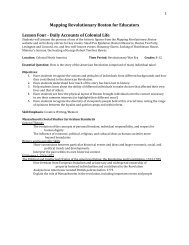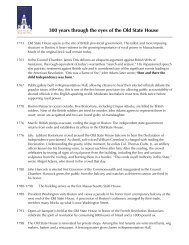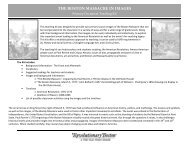Sweet History: Dorchester and the Chocolate ... - Bostonian Society
Sweet History: Dorchester and the Chocolate ... - Bostonian Society
Sweet History: Dorchester and the Chocolate ... - Bostonian Society
Create successful ePaper yourself
Turn your PDF publications into a flip-book with our unique Google optimized e-Paper software.
SWEET HISTORY: <strong>Dorchester</strong> <strong>and</strong> <strong>the</strong> <strong>Chocolate</strong> Factorywww.bostonhistory.org/bakerschocolate/Development of <strong>the</strong> Lower Mills AreaFor much of <strong>the</strong>ir early history, <strong>Dorchester</strong> <strong>and</strong> Milton were primarily agriculturalcommunities. European settlers brought cattle <strong>and</strong> seed for crops, <strong>and</strong> learned to growcorn from <strong>the</strong> Naive Americans. There were also a few shipbuilding operations makingsmall crafts <strong>and</strong> a local fishing industry. Israel Stoughton’s grist mill, known as <strong>the</strong>Neponset Mill, stood alone along <strong>the</strong> river for forty years. In was not until 1674 that ano<strong>the</strong>rmill, one to make gunpowder, was erected slightly down-river on <strong>the</strong> <strong>Dorchester</strong> side. 147Gradually small dams were introduced to control <strong>the</strong> Neponset’s flow <strong>and</strong> more effectivelymaintain water power during dry periods. These dams became important over <strong>the</strong> nextcentury as more mills were built on both sides of <strong>the</strong> river to saw wood, manufacturewoolen cloth, <strong>and</strong> to make paper, snuff, <strong>and</strong> chocolate. By <strong>the</strong> Revolutionary War, <strong>the</strong>growing Neponset Village (Lower Mills area) was quite an industrial center, keeping <strong>the</strong>communities supplied in bread flour, lumber for shelter <strong>and</strong> ships, wool for clothing, <strong>and</strong>gunpowder for hunting <strong>and</strong> protection. 148Growth of <strong>the</strong> Lower Mills as an Industrial CenterThe first mills in <strong>the</strong> area made products that were intended for local consumption. Asmore mills introduced specialized goods, <strong>the</strong> range of commerce broadened to make <strong>the</strong>Lower Mills area an important manufacturing site. By 1728 <strong>the</strong> Lower Mills was one of<strong>the</strong> most notable, long-lasting industrial centers on <strong>the</strong> continent. As times <strong>and</strong> technologychanged not all mills survived. Gradually Baker’s bought up o<strong>the</strong>r mills to exp<strong>and</strong> <strong>the</strong>company’s capacity for chocolate making, by <strong>the</strong> turn of <strong>the</strong> twentieth century Baker’swas a prominent industry in <strong>the</strong> Lower Mills. 149Following are brief descriptions of <strong>the</strong> different types of industrial mills located on <strong>the</strong>Neponset in <strong>Dorchester</strong> <strong>and</strong> Milton over <strong>the</strong> centuries.Grist MillsBefore <strong>the</strong> mills were built, <strong>the</strong> New Engl<strong>and</strong> staple of Indian corn was ground by cracking<strong>the</strong> kernels in a mortar to make hominy grits. This coarser product was only suitable forcooking, not baking. Grist mills ground corn more efficiently <strong>and</strong> to a finer consistency toproduce corn meal for baking bread. 150To grind corn, two large millstones were set on top of each o<strong>the</strong>r, slightly apart, <strong>and</strong> couldbe adjusted for <strong>the</strong> required coarseness. The top stone, or runner stone, had a hole in itwhere whole corn kernels were dropped in. The grinding faces of <strong>the</strong> stones had spiralgrooves to help in <strong>the</strong> grinding process <strong>and</strong> move <strong>the</strong> finer corn meal away from <strong>the</strong>center of <strong>the</strong> stones. When <strong>the</strong> meal was at <strong>the</strong> desired consistency, sifters removed anyhusks <strong>and</strong> <strong>the</strong> corn meal was ready for use. 151 147 Hamilton, <strong>History</strong> of Milton, 65, 68; Matthai <strong>and</strong> Greenberg, Draft Report, 30. 148 Hamilton, <strong>History</strong> of Milton, 71, 75; Matthai <strong>and</strong> Greenberg, Draft Report, 35. 149 Hamilton, <strong>History</strong> of Milton, 71. 150 Hamilton, <strong>History</strong> of Milton, 64; Matthai <strong>and</strong> Greenberg, Draft Report, 37. 151 Hamilton, <strong>History</strong> of Milton, 64; Matthai <strong>and</strong> Greenberg, Draft Report, 37, 62.44 of 76© 2005 The <strong>Bostonian</strong> <strong>Society</strong>. Nothing from <strong>the</strong> site can be reproduced without specific written permission issued by:The <strong>Bostonian</strong> <strong>Society</strong> • 206 Washington Street • Boston, MA 02109-1773. Any questions, call 617-720-1713.






